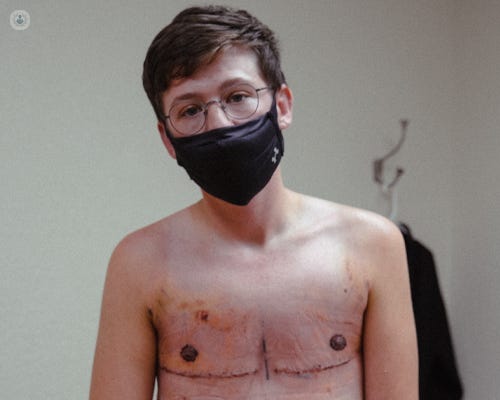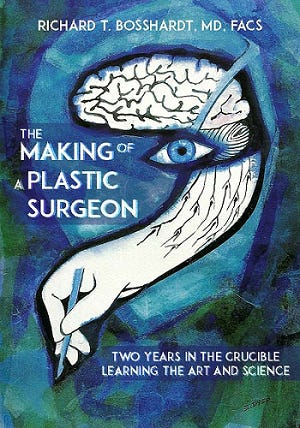Can We Please Stop Calling it 'Top Surgery!?'
Using a cutesy euphemism for cutting off the normal breasts in young girls is repugnant and most stop
When medicine challenges the most basic, fundamental, and, until recently, universally accepted premise in human biology you know there’s a problem
Like so many such things, I cannot recall the first time I heard a challenge to the reality of binary sex, i.e. male and female. These have always been considered immutable; you cannot switch at will from one to the other. And, no, clownfish don’t count. Binary, immutable sex has been upended by queer theory, which birthed the appalling practice of medical experimentation on children, called gender-affirming care, for those who believe they are trapped in the wrong body. A fixed belief that contradicts reality is a delusion and nowhere in medicine, except in gender-affirming care, is delusional thinking encouraged and affirmed.
The shift in thinking is reflected, as it so often is, in the language used to discuss this issue. In the vernacular of those who are upsetting the applecart of sex and gender, women are “birthing persons”, breast feeding is “chest feeding”, and sex/gender is “assigned at birth” by a third party rather than established by the fusion of gametes at conception.
I am not going to discuss any of the above. I want to simply address the practice of what is euphemistically called “top surgery,” a term I abhor because it trivializes a major, life-changing operation. As a plastic surgeon, I am by training and experience an expert on the technical aspects of breast surgery
Top surgery in the realm of gender-affirming care refers to the surgical modification of breasts in order to affirm someone who believes they are the opposite sex (note: it is always one or the other; there is never a third sex). Because most young trans-persons these days are adolescent girls by a ratio of more than two to one, it typically involves removal of both breasts to masculinize the chest. Surgeons call this operation a bilateral mastectomy, an operation usually done to treat breast cancer.
As done for gender-affirmation, a mastectomy involves removal of as much breast tissue as possible while preserving the skin and nipple/areola complex. It is a technically demanding surgery and much easier in small, non-sagging breasts. In someone with large breasts, removal of a lot of skin adds another dimension of challenge. The goal of a fully male chest is never achieved. For one thing, there will be permanent surgical scars which may vary from faint to disfiguring, but are always visible. The contour of the chest may be abnormal or uneven. I see many results online that are far from ideal. If someone is uncomfortable with their normal chest, I cannot but wonder how they will feel about a less-than-ideal result with permanent scars. In addition, the nipple areola/complexes will be permanently numb because of the inevitable cutting of sensory nerves. It should go without saying that breast feeding a child will be impossible.
Complications of a mastectomy include loss of one or both nipples and/or skin due to poor circulation, disfiguring scars, chronic pain, and all the potential complications inherent in any major surgery: infection, bleeding, anesthesia-related complications, blood clots, and other problems, some of them life-threatening.
As demanding as a cutting off a breast in a mastectomy is, it pales in comparison to trying to build a breast. Dr. Joanna Olson-Kennedy, a pediatrician and one of the most aggressive and recognized advocates for gender-affirming care, was asked about girls who later regret their decision to have their breasts removed. In obvious exasperation, she smugly stated, “And here’s the other thing about chest surgery. If you want breasts at a later point in your life, you can go and get them!” (17:00 in the video). You can view the full video here.
Dr. Olson-Kennedy cites a “zero” rate of regret after top surgery. This alone should make anyone skeptical since the operation with 100% satisfaction has yet to be discovered. One major concern about regret, or de-transitioning as it is called, is that there are no diagnosis codes for this so patients who seek to reverse their transition are essentially invisible to data gatherers and insurers.
Her comment shows a dangerous level of arrogance and ignorance regarding breast reconstruction. If she is telling patients this, she is seriously misinforming them.
Breast reconstruction with one’s own tissue is a major surgery which requires shifting skin, fat, and, sometimes, muscle, from one area of the body to the chest and using these to build a breast. There are a number of variations on this. All are major surgeries. Some require the expertise of a surgeon using microvascular techniques. This type of reconstruction leaves not one, but two, surgical sites, both with potential for complications. In a worst case, failure of the reconstruction can be catastrophic. Complication rates run as high as 30% or more in some studies with total failure rates around 7%.
Reconstruction using breast implants requires a two-stage process. In the first an expandable balloon is placed in each mastectomy site. These are gradually inflated over a period of several months until sufficient space is created to replace them with permanent breast implants in a second surgery. The limitations of implant reconstruction are well known to all plastic surgeons. The reconstructed breasts will never look or feel normal. All implants may be seen or felt through the thin skin overlying them. Implant-related complications include, but are not limited to, hardening of the breasts due to contracture of scar around the implants, visible rippling, malposition, extrusion due to thinning of the overlying skin, and a high likelihood of needing additional surgery later.
No reconstruction produces a remotely natural, functional breast.
To suggest that “top surgery” is as simple as just going and getting a pair of new breasts is so absurd that someone who promotes this should be viewed as uninformed and totally unreliable. To advocate for this in pubescent, gender-confused minor girls, as young as 13-years-old is so appalling that designating this as criminal malpractice is not too strong a term.
A final word on so-called top surgery. It is, by far, the most commonly performed surgery for gender transitioning, probably because plastic surgeons are comfortable operating on breasts. In comparison, so-called “bottom surgery” to create genitalia of the opposite sex is orders of magnitude more complex and therefore less often sought or performed. Relatively few surgeons perform this type of surgery in minors because of the technical difficulties and ethical issues raised.
In closing, I will add that I strongly believe that we will one day view the current gender-affirming care of minors with gender dysphoria as a cruel abomination and regard it with the same revulsion that we now do frontal lobotomies.
Richard T. Bosshardt, MD, FACS, Senior Fellow at Do No Harm
The Making of a Plastic Surgeon- Two Years in the Crucible Learning the Art and Science, will provide readers with a unique, honest glimpse of what it takes to practice this fascinating and misunderstood specialty. You can get in eBook and paperback.





Rick, As always, I enjoyed your comments. They reflect your many years of training and professional experience. I agree with all you say. How can those of us layfolks best make our voices heard?